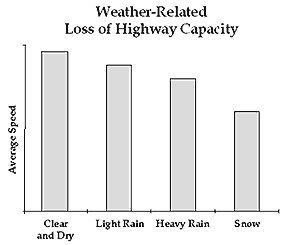Road Weather Management Overview
Road Weather Challenges
Adverse weather affects all of us. A snowstorm can shut down a city for an entire day or more. Weather emergencies, such as hurricanes, can prompt massive evacuations, causing gridlock and putting lives at risk. But it doesn't take a catastrophe to wreak havoc—even a rainstorm can paralyze a rush-hour commute. During bad weather, every year on our highways there are nearly 6,500 fatal crashes and over 450,000 injury crashes.
 Source:
Oak Ridge National Laboratory, Temporary Losses of Highway Capacity
and Impacts on Performance
Source:
Oak Ridge National Laboratory, Temporary Losses of Highway Capacity
and Impacts on PerformanceAdverse weather is the second largest cause of non-recurrent congestion. Snow, ice and fog alone cause 15 percent of non-recurring delay. Likewise, a light rain can increase travel time delay by 12 to 20 percent. This translates into financial impacts. In metropolitan areas truckers lose about $3.4 billion (about 32 million hours) stuck in weather-related traffic delays. A one-day highway shutdown can cost a metropolitan area up to $76 million in lost time, wages, and productivity.
What We've Learned
While we cannot change the weather, we can reduce its impact on highway safety and operations. Today we can predict weather changes, identify threats to the highway system, and proactively respond. Transportation system operators can warn people of changing weather, manage the infrastructure, and respond to conditions in real time through:
- Pre-treating roads with anti-icing materials
- Pre-positioning trucks for de-icing, sanding, or plowing
- Advanced freeway management, including variable speed limits
- Traffic signal optimization through adaptive control
- Accelerated incident response
- Real-time information dissemination to travelers and managers using
varied media

Benefits of weather responsive transportation management are already being realized by some transportation agencies. For example:
- Maintenance managers in Idaho reduced crashes by 83 percent, labor hours by 62 percent, and material costs by 83 percent using road weather sensors to manage the application of anti-icing treatments.
- In Tennessee, a fog detection and warning system on I-75 resulted in a decline in fog-related crashes from more than 200 between 1973 and 1993, to just one between 1994 and 2002.
A critical component to implementing weather responsive strategies is having the appropriate weather information and products. This includes having route specific weather information and forecasts in the appropriate time frame and format. In most places across the country, this information is simply not yet available.
What We're Doing
The Federal Highway Administration's (FHWA) Road Weather Management Program seeks to develop and promote effective tools to observe and predict the impacts of weather on the roads, and to alleviate weather impacts. The programs objectives are:
- Develop a national, open observing system that promotes data sharing to support weather observing and forecasting and transportation operations
- Develop resources and training methods to assist state and local partners in deployment of weather management tools
- Advance the state-of-the-practice by developing proactive solutions and disseminating information on adverse weather
- To foster a collaborative, comprehensive, and dedicated surface transportation weather research program
Fundamental to road weather management is the sharing and integration of data and information. This supports the demands of travelers who have been found to want weather and road condition information more than any other type of traveler information. To that end, the vision of the Road Weather Management Program is Anytime, Anywhere Road Weather Information.
This vision will only be realized through close collaboration and coordination across the transportation and weather communities. For this reason, FHWA is working with weather and transportation partners to facilitate technical and institutional integration within and across agencies. The goal is to get the right information into the right people's hands so they can make the right decisions. To that end, FHWA is promoting the use of sensor and communications standards, working with the weather community to develop quality control algorithms, and defining the best methods for data sharing and processing.
Future Directions
A key component to achieving the vision is to understand the information requirements of the end users. FHWA documented these requirements which were then published in a document entitled Weather Information for Surface Transportation — National Needs Assessment Report. This report compiles weather information needs across the surface modes, building a strong foundation for research, development and deployment in support of proactive strategies to mitigate weather's effects on the transportation system.
In the coming years, research will focus on integrating weather information into traffic management systems and traffic models and determining how different weather events affect traffic flow characteristics, particularly on arterial streets.
FHWA is committed to supporting a robust and competitive market in road weather services. One development strategy is to conduct the high-risk research and then hand the products to the private sector, which can incorporate these capabilities into the services they provide to end users. This strategy is being successfully applied in the Maintenance Decision Support System project.
Another important aspect to advancing road weather management is through educating and providing resources to state and local agencies. A one-day training course called Fundamentals of Road Weather Management will soon be available to meet that need. The objectives of the course are to understand the road weather problem, know basic meteorology affecting the roadway, and raise awareness of strategies to mitigate the effects. Additional resources can be found on the Road Weather Management Web site.
The impacts of weather on the nation's roads are significant
but can be reduced through focused efforts. Such efforts support the
FHWA goals to improve reliability, safety and security through "21st
Century Operations using 21st Century Technology."
Download Word Document (DOC, 200K)
To view DOC files, you need the Microsoft Word Viewer.


